1982 Honda Accord Reviews
You'll find all our 1982 Honda Accord reviews right here. 1982 Honda Accord prices range from for the Accord to for the Accord Ex.
Our reviews offer detailed analysis of the 's features, design, practicality, fuel consumption, engine and transmission, safety, ownership and what it's like to drive.
The most recent reviews sit up the top of the page, but if you're looking for an older model year or shopping for a used car, scroll down to find Honda dating back as far as 1977.
Or, if you just want to read the latest news about the Honda Accord, you'll find it all here.
Honda Accord Reviews
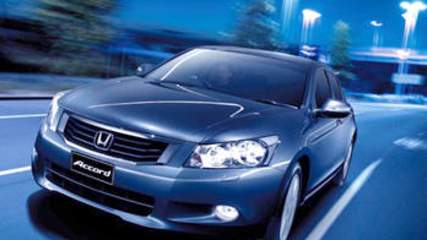
Honda Accord VTi-L 2008 review
Read the article
By John Parry · 29 May 2008
Honda's latest Accord strikes deep into homegrown territory.It is similar in size to Commodore, Falcon and Aurion, comes loaded with equipment, a choice of four and V6 engines, and is priced to hit the locals where it hurts.And the V6 is clever enough to run on six, four or three cylinders, to save fuel.This eighth-generation Accord is aimed at buyers looking for a large car at a keen price, with what Honda claims will be low running costs and a high retained value.Prices reflect the free-trade agreement — no 10 per cent import tax — with Thailand, where the Accord is built.There are two 2.4-litre, four-cylinder models, the VTi at $29,990 and the VTi-L at $36,490, and two 3.5-litre V6 models, the V6 at $38,490 and the V6-L at $46,990.The new Accord is a larger car all round and a genuine adult five-seater.Park it alongside its local rivals and it doesn't look any bigger, but it is 51mm longer than a Commodore, 15mm longer than a Falcon and bigger all round than an Aurion.However the width is trimmer — 54mm narrower than a Commodore and 18mm narrower than a Falcon.Behind the wheel it doesn't look or feel as big as the locals, due to the chamfered corners, wraparound lights, curved bumpers, slim roof pillars and a sloping tail.Boot volume doesn't match the locals, but it does have a full-sized spare wheel.The 2.4-litre, four-cylinder version is, as expected, no fireball. But it does its job admirably.Tweaking the variable valve timing has helped lift power and improved fuel economy.Output from the 2.4-litre engine is up 8kW to 133kW, and up 4Nm to 222Nm. Its combined fuel economy (standard unleaded) has improved 8 per cent, to 8.8 litres/100km.Complementing the engine is the decisive and intuitive five-speed automatic.Acceleration and mid-range response are brisk enough once it gets into stride and it cruises easily on the open road.It is also relatively quiet and composed.The transmission has an S (sports) slot below D (drive) and steering-wheel paddle shifters.In S it operates in the first three ratios only, or by triggering the paddle shifts, allows manual selection of all five ratios.The paddle shifts can also be activated in drive. This is useful when slowing, and reverts back to full auto after five seconds.The upgraded V6 is a worthy rival to the Aurion for response and smoothness.A lift in capacity, from 3.0 to 3.5 litres, has increased power by 25kW to 202kW and torque by 52Nm to 395Nm.This just pips the Aurion as the most powerful engine in its class.Step-off response is lively and the punch continues seamlessly through to maximum revs.It also has the advantage of a three-mode cylinder deactivation system, to improve fuel economy.Under load the engine fires on all six cylinders. When cruising and at light throttle it runs on three cylinders and in between it runs on four cylinders.The transition is automatic and silent, apart from a slight exhaust growl on trailing throttle.Whenever the green `Eco' light comes on, on light or trailing throttle, the driver gets a warm fuzzy feeling.Honda says fuel economy improves 6 per cent over the previous V6 to 10 litres/100km on the combined cycle, marginally above the Aurion.Dynamically the Accord is a safe and reassuring car to drive, although enthusiastic drivers will be left looking for more.The suspension is set up to deliver a smooth and compliant ride over all surfaces and confident and secure handling.Steering is light and accurate enough and the brakes confident.The interior is attractive, with well-placed controls, high-quality trim and plenty of storage.The driving position suits all sizes, the seats are supportive and head and legroom are generous for five adults.Standard equipment includes stability control, front and side airbags, traction control, dual-zone climate control, a five-speed automatic transmission, cruise control, steering wheel paddle shifters and audio controls, a six-CD 160W audio system, steering wheel audio controls, power windows and alloy wheels, but no trip computer.The rear seat folds and has a ski-port, but no split fold.Parking sensors are an option on all models.The VTi Luxury adds heated front seats, the V6 lumbar support for the driver and side mirror indicators and the V6 Luxury adds satellite navigation, a reverse camera and a trip computer.Maximum towing weight is 1200kg, or 400kg below its rivals.
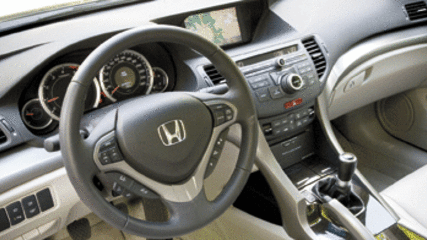
Honda Accord Euro Sedan 2008 Review
Read the article
By Kevin Hepworth · 16 May 2008
There is nothing radical about the new Honda Accord Euro. It's evolution over revolution — a philosophy Honda has made something of a catchcry — after the big breakthrough with the first Euro five years ago.Even the price will be much the same, with a small increase on the current $33,990 base when cars arrive next month.The sportier four-cylinder Accord Euro will again sell alongside the US-styled wide-bodied V6 car in a two-pronged strategy that has worked well in Australia.This time the Accord Euro changes are more subtle, the improvements more focused and the outcomes less radical. And that is just fine with Honda Australia boss Lindsay Smalley.“The original Accord Euro hit a mark for us. There have been 45,000 Accord Euros sold since mid-2003, making it out best-selling sedan,” says Smalley, speaking at the international launch in Vienna.“To make radical changes to something that successful would not have made sense.”Smalley says the two-Accord approach works well and will not be touched.“When we introduced the two-Accord strategy, there was much concern that it would lead to confusion.“However, we have been able to sell Accord and Euro Accord side-by-side to two vastly different buyer profiles,” he says.Even so, the difference between the two cars in 2008 is so great that Honda is claiming a new segment for the Euro . . . the Advanced Premium Sport Segment.“In the European markets, the car is being sold against Audi, Mercedes-Benz and BMW,” Smalley says.“That is not going to be the case in Australia where we will sell mainly against VW Passat, Subaru Liberty and Mazda6 with some shot at some of the prestige brands.”The Euro Accord will have a single 2.4-litre petrol engine linked to either a six-speed manual or five-speed automatic transmission. And there's three specification levels: Euro, Euro Luxury and Euro Luxury Navi.The chances of the 2.2-litre diesel joining the stable within the next 12 months have been improved by the announcement that the torquey four-cylinder will gain a five-speed automatic next year.Specification levels will be high. The base car will have six airbags, electronic stability control, anti-skid brakes, cruise control, automatic airconditioning, 10-speaker six-CD stereo, 17-inch alloys with a full-size spare, reach and rake steering adjustment, power steering, active headrests and cloth trim.The Luxury model adds sunroof, leather interior, heated seats, eight-way power seat adjustment, 18-inch alloys (space-saver spare), HID headlights, rain-sensing wipers fog lights and front and rear parking sensors. The top-line Euro Luxury Navi gets an Alpine navigation system, Bluetooth preparation and reversing camera.On the roadThe best way to describe the new Euro is refined. The car feels solid yet rides the — admittedly good — Austrian roads with an aplomb many above it may envy.It is not difficult to believe that much of the engineering improvement in the car has been concentrated on the chassis.Though longer, wider and with a wider track, the new Euro sits lower. The engine and fuel tank have also been lowered within the structure. It exudes an even sportier essence than the model it replaces.Improved body rigidity, through increased use of ultra-high tensile steel and re-engineering of the front body structure — combined with an all-new front double wishbone and rear multi-link suspension — gives the Euro a noticeable improvement in stability when cornering.Refinement levels have been improved, partly by the stiffening of the chassis and with additional sound absorbing and deadening materials lining the cabin.With 147kW and 234Nm — both counts up slightly — the 2.4-litre motor is never going to outpace any of the true performance sedans, but it doesn't need to.Performance is adequate. It is unfussed and largely stress-free, either with the slick six-speed manual transmission or the slightly less engaging five-speed automatic gearbox.The diesel, as is generally the case, is the stronger of the two engines with its 110kW and 350Nm output giving it enough top end to justify getting there quickly through the hugely torquey mid-range.Steering is light yet not uncommunicative. There were times on the test drive when the front wanted to push on, but never in a nasty manner.Interior space in the Euro is generous for the class, particularly in the front, where there is no need to rub shoulders.The news is not as good for rear-seat passengers, where space is more of a premium, particularly if those in the front choose to stretch.Trim in the high series cars driven at launch is stylish, and the fit and fitment is what you would expect from a car with prestige aspirations. Price: About $34,000On sale: JuneEngine: 2.4-litre four-cylinder petrol, 2.2-litre turbodieselPower: 147kW, 110kWTorque: 234Nm, 350NmTransmission: Six-speed manual (petrol and diesel), five-speed auto (petrol), front-wheel driveEconomy: 8.9 litres for 100km (petrol), 5.9 litres/100km (diesel)
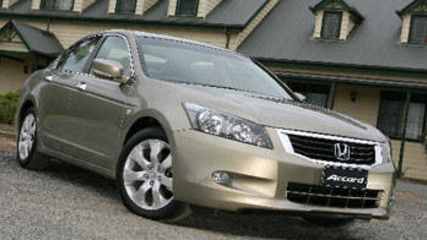
Honda Accord V6 2008 review
Read the article
By Stuart Scott · 09 May 2008
Thinking along these lines, the new Honda Accord V6 sedan is George Clooney on wheels; instant charisma and good looks galore.Well-mannered, too. Just driving around the block it feels impressive, and the farther you go, the better it seems to get.Honda stepped up the wow factor when it created the current model Civic and now has come up with a new version of its larger brother, the Accord, obviously a graduate from the same charm school.The six-cylinder model — there's a less clever, less powerful and, naturally, less costly four-cylinder variant — is such a fitting flagship, boasting a silken engine along with excellent road manners.This is the eighth generation of the Accord series in more than 30 years. Bigger than ever. Classier than ever.Accords once were medium-sized cars; this one is longer than a Holden Commodore but weighs less, and its six-cylinder engine delivers more power but drinks less.In the efficiency stakes in its class, only the smaller Toyota Aurion manages to beat the Accord on fuel economy — by a mere 0.1 litres per 100km on the official figures — while not quite matching the Honda power/torque output.The secret of the Accord V6's success is that it runs happily on only three or four cylinders when full power is not required. (The Americans have been embracing this idea for years, with the current Chrysler 300C also proof that it works.) In engineer-speak, this is “three-stage variable cylinder management.”It switches itself on and off unobtrusively. A green “eco” light on the instrument panel tells the driver when part of the engine has gone to sleep, but everything comes awake and very much alive — instantly, smoothly — at the slightest prod on the accelerator.Then it simply growls and gets going.Even when firing on all cylinders, the Accord manages to be exceptionally quiet and refined as it ambles along. You almost wonder if the engine is still running, but it is.So it's quite an achiever, combining refinement with top-class dynamics.It gives a comfortable ride while gripping well on corners and steering with real precision. And this, in theory, is the non-sporty member of the family, so it will be interesting to see what Honda has in store with the more athletic Accord Euro version — a different body that's smaller and set up for spirited European-style driving — which is coming later this year.The Accord Euro is built in Japan, the Accord in Thailand. No complaints on quality and it helps keep costs down.Previously, Accords have been about comfort and genteel touring rather than agility and on-road poise.But the newcomer, considerably bigger than its predecessor, manages to feel much livelier.
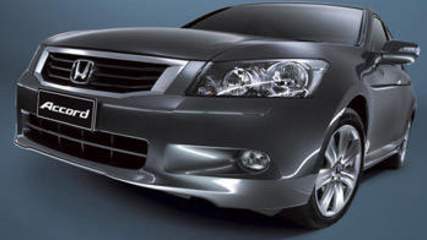
Honda Accord 2008 review
Read the article
By Stuart Scott · 29 Apr 2008
Thinking along those lines, the new Honda Accord V6 sedan is George Clooney on wheels: instant charisma, and good looks galore. Well-mannered, too. Just driving around the block it feels impressive, and the farther you go, the better it seems.Honda stepped up the wow factor when it created the current-model Civic, and now has created a new version of its larger brother, the Accord, obviously a graduate from the same charm school.The six-cylinder model — there is a less clever, less powerful and, naturally, less costly four-cylinder variant — is such a fitting flagship, boasting a silken engine along with excellent road manners.This is the eighth generation of the Accord series in more than 30 years, bigger than ever, classier than ever. Accords once were medium-sized cars; this one is longer than a Holden Commodore but weighs less, while its six-cylinder engine delivers more power but drinks less.In the efficiency stakes in its class, only the smaller Toyota Aurion manages to beat the Accord on fuel economy — by a mere 0.1 litres per 100km on the official figures — while not quite matching the Honda power/torque output.The secret of the Accord V6's success is that it runs happily on only three or four cylinders when full power is not required. (The Americans have been embracing this idea for years, with the current Chrysler 300C also proof that it works.)In engineer-speak, this is “three-stage variable cylinder management”. It switches itself on and off unobtrusively.A green “eco” light on the instrument panel tells the driver when part of the engine has gone to sleep but everything comes awake and very much alive — instantly, smoothly — at the slightest prod on the accelerator. Then it simply growls and gets going.Even when firing on all cylinders, the Accord manages to be exceptionally quiet and refined when ambling along. You almost wonder if the engine is still running, but it is.So it is quite an achiever, combining refinement with top-class dynamics. It gives a comfortable ride while gripping well on corners and steering with real precision.And this, in theory, is the non-sporty member of the family. So it will be interesting to see what Honda has in store with the more athletic Accord Euro version, a totally different body that's smaller, narrower and set up for spirited European-style driving, which is coming later this year.The other big difference between these far-from-identical twins is that the Accord Euro is built in Japan, while the Accord is built in Thailand. No complaints about the quality, and it helps keep the cost down.Previously, Accords have been about comfort and genteel touring rather than agility and on-road poise.But while the newcomer is considerably bigger than its predecessor (and looks a lot sharper, by the way), it manages to feel much livelier.HONDA ACCORD V6: Large front-wheel drive sedan, 3.5 litre V6 engine (power 202kW, torque 339Nm) and five-speed auto transmission.Stability control, anti-lock brakes, six airbags, dual-zone aircon, six-disc CD player, cruise control, alloy wheels, full-size spare tyre.
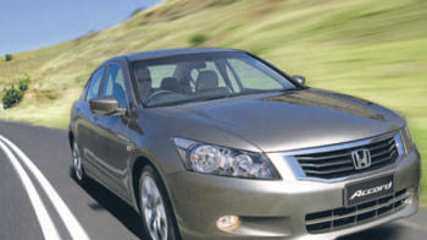
Honda Accord VTi 2008 review
Read the article
By Neil McDonald · 07 Mar 2008
More than 10 million cars have been sold globally and for the past few years two models, the Accord and Accord Euro, have been available in Australia.The eighth-generation Accord has just arrived in showrooms and the replacement Euro will be unveiled at the Geneva Motor Show, which opens in Switzerland.Like our Australian-built Toyota Camry, the Thai-built Accord comes with a choice of four-cylinder or V6 engines.But Honda does not pretend its V6 is anything but an Accord, whereas Toyota has tried to separate the Camry and its V6 model by calling the latter the Aurion.In the Accord, the 2.4-litre i-VTEC four-cylinder is reserved for the entry VTi and VTi Luxury. It develops 8kW and 4Nm more than the old car.The V6 has grown from 3.0-litres to 3.5-litres, now develops 202kW/339Nm and has variable cylinder management. This means the car can run on six, four or three cylinders, depending on driving conditions, and saves about 8 per cent in fuel over a V6 with cylinder deactivation.The system allows the 3.5-litre V6 to deliver 10 litres for 100km. The 2.4-litre manages 8.8 litres for 100km on the combined cycle.Both the four and V6 have five-speed automatic transmissions driving the front wheels.The sedan has grown slightly, being 115mm longer, 25mm wider and 20mm higher than the previous Accord. The wheelbase has grownto 2800mm, 60mm more than the previous car.Underpinning the car is the same front double-wishbone suspension, now with anti-dive geometry, and the rear gets a new multi-link design built into a stiffer body structure that gives the rear suspension 40 per cent better lateral rigidity.The bigger body translates into a roomier cabin, and torsional rigidity is up 20 per cent thanks to the use of high-tensile steel.Because the car is sourced from Thailand, which enjoys free-trade status with Australia, Accord pricing is sharp.The 2.4-litre VTi is $29,990, the VT-i Luxury $36,490, the V6 $38,490 and V6 Luxury $46,990.Standard equipment includes dual-zone climate control, height and reach-adjustable steering wheel, five-speed automatic transmission, active front headrests, anti-skid brakes, dual front and side airbags, stability control, traction control and electronic brake assist.Curtain airbags are standard on the 2.4 VT-i Luxury, V6 and V6 Luxury, along with electric driver's seat.The Luxury models get heated front seats, leather upholstery and a leather-wrapped gear lever.The V6 also gets active noise control, and the V6 Luxury adds curtain airbags, a trip computer, navigation system and reversing camera.Honda Australia director Lindsay Smalley says the company expects to sell 800 a month. The entry model should account for 60 per cent of sales.He says there are no plans for an Accord diesel in the short term. Honda's philosophy is hybrid for its smaller cars and diesel for its larger ones.“We are watching the rise of consumer interest in diesel and studying it,” Smalley says.“The issue is that with a diesel we would need an automatic transmission for our markets.”I am not a big fan of gimmicks, but the active noise control and cylinder deactivation on the 3.0-litre Luxury works a treat.The noise control, first seen on the Legend, removes the low-frequency peripheral noise from the cabin, delivering a more serene ambience.The system uses two microphones, one in the overhead console and the other on the rear parcel shelf, to pick up low-end drivetrain noise entering the cabin.The signal is sent to an electronic processor which, in layman's terms, helps cancel the original noise signal.Then there's the sophisticated variable cylinder management system on the 3.5-litre V6, which deactivates cylinders depending on the driving conditions.It allows the engine to operate on six, four or three cylinders, improving fuel economy.Honda quotes a fuel figure of 10 litres for 100km for the V6, which sneaks under its rivals, Holden VE Calais, current-model Ford Fairmont Ghia and Toyota Aurion V6.The variable cylinder management operates almost seamlessly and most drivers will be unaware which cylinders are not working.Only the eco-green dashboard light tells you that the engine is operating in its most economical mode.With 202kW on tap from the 3.5-litre V6, the Accord Luxury does a reasonable job of getting the 1650kg sedan moving. There's enough mid-range response for overtaking and the engine will go up to 7000 revs without complaint.The 2.4-litre four-cylinder engine in the base car lacks the crisp power delivery of the V6, but with 133kW on hand it does a good job of moving the metal in a smooth manner.Other areas that have improved over the old car are ride and handling. The previous Accord, let's be blunt, was a softy. The new car is more precise.It does not lose its composure over rougher roads and the suspension is tuned better.But the steering remains dull and over-assisted at speeds above 60km/h. More feedback would be welcome.The bonus with Hondas is they have impeccable build quality. The Accord is no different, despite being built in Thailand.We also love the fact Honda has included a full-size spare but the boot floor design does unnecessarily intrude into available space.
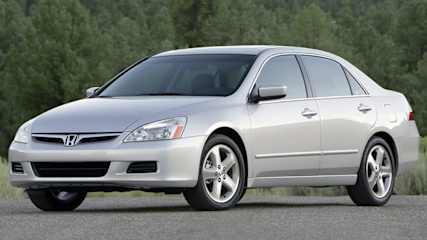
Honda Accord 2006 Review
Read the article
By Peter Barnwell · 04 Feb 2006
Undelining this is the number of accolades won by the Euro.So it comes as no surprise that when upgrade time comes around, Honda isn't about to implement wholesale changes to one of its best selling models.Such is the case with the '06 Accord Euro which has undergone minimal changes to the front and rear bumpers, grille and wheels. That's about the strength of it but satellite navigation is now available as an option on the high spec' Luxury model – for $3000.Sharp eyed car spotters might also notice changes inside to the fascia and trip computer but that's about it.The price starts at $33,500 for the manual Euro which is great buying considering what you get. Move up to the Luxury at $42,500 and it's a whole lot better.The new look is more appealing than ever and our satnav equipped test car was great to drive for the week especially with its fully integrated guidance system taking us here and there.But the car's essentials remain the same: potent 2.4-litre four cylinder engine with 140kW/223Nm output, remarkable fuel econ- omy for a medium size prestige car, great handling and ride and heaps of style.The five-speed auto test car was a treat to drive in all conditions particularly when using the sequential shift mode with the change in the right direction, pulling back for up and push away for down. The five ratios harness Euro's power smoothly and contribute to the impressive economy which can get down to 8.0L/100km.Interior luxury is bountiful stretching to full leather and climate control, premium audio, multi function information system, sporty seats and steering wheel, and power assistance for most ancillaries.It will take five at a pinch, four adults in comfort and the boot is a good size.What we really like about the Euro, apart from just about everything else is its styling – subtle, aggressive, sporty, sexy, classy – it still has as much appeal as it did at launch in 2003. Many new models don't look half as good today.Yep, if it was our money on the line, this car would be on the short list.
Used Honda Accord review: 1993-1997
Read the article
By Graham Smith · 10 Dec 2005
Its lines were clean, its surfaces smooth, only its tail was clearly derivative, being a copy of the E36 3-Series BMW. Up against the likes of the Toyota Camry, Mazda 626, Mitsubishi Galant, Nissan Bluebird and Hyundai Sonata, the Accord was pleasantly different.MODEL WATCHIt was the technology learned from Honda's involvement in Grand Prix racing that began to filter through to the production models in the early 1990s. The most obvious being the VTEC engine with variable valve timing and lift, which changed engine design in a fundamental way.The idea was brilliant. By varying the time the valves opened and closed, and altering the valve lift, the engine could be tuned to deliver good torque and fuel consumption as well as plenty of power.Honda made the modest claim that the VTEC engine developed less than 5 per cent more power than the equivalent engine without variable valve timing, but it also produced up to 8 per cent better fuel consumption and boasted better mid-range torque. The VTEC engine was one of two 2.2-litre four cylinder engines Honda offered in the Accord.Apart from the VTEC variable valve timing, it had a single overhead camshaft, four valves per cylinder and fuel injection, which combined to belt out 107 kW at 5000 revs and 198Nm at 4500 revs. The standard engine was a carry over from the previous model. Its peaks were 103kW at 5600 revs and 192Nm at 4500 revs.Both engines were smooth, thanks largely to a balance shaft. Each could be linked to either manual or automatic transmissions. Four-wheel discs did an admirable job of slowing the Accord, while standard power steering made light of the wheel work.Three models made up the range. It started with the EXi sedan which had the base engine along with airconditioning, central locking, power windows, cloth trim and four-speaker radio/cassette sound. Cruise control was added in 1996. The remaining models had the VTEC engine. The VTi sedan and wagon added alloys, a sunroof, power driver's seat and a couple of extra speakers. The VTi-S sedan also had leather trim, anti-skid brakes and a driver's airbag.IN THE SHOPTechnology needs to be serviced and that goes particularly for Hondas. It's crucial that the engine oil is changed regularly to prevent sludge from building up, and equally important that the cam timing belt be changed every 100,000 km.Same goes for the gearboxes. The manual was not a worry, but the auto needs regular servicing and it's important to use Honda-specified transmission oil. The Accord's chassis gives little trouble, but check for ticking noises that might indicate a problem with a CV joint.CRUNCH TIMEAgile handling along with four-wheel disc brakes (anti-skid on VTi-S and all models from 1995) gives the driver a good chance of avoiding a crash. The Accord's stiff body and a driver's airbag provide quite good protection in a crunch.RATING15/20 Well-engineered, well-built, prestige, medium-size car that offers good value as a used buy for the long haul. The Accord stands out well against its rivals.
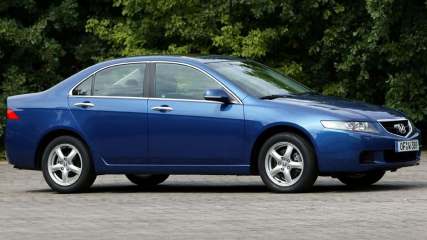
Honda Accord Euro 2005 Review
Read the article
By CarsGuide team · 16 Jul 2005
The Accord Euro is available only with a four-cylinder engine. The rounded Accord is available with either a V6 engine or a four-cylinder.The prices of all three Accords dropped early this year as Honda passed on tariff savings. That meant the Accord Euro dropped to $33,500 and the Accord V6 to $36,990.The cheapest model is the VTi, which costs a reasonable $29,990. The four-cylinder Accord Euro has 140kW. The 2.4-litre VTi has 118kW and 218Nm. It uses a five-speed automatic transmission.The mid-sized VTi is actually larger than the Accord Euro, with a sizeable boot and cabin space.For a car that comes in at just under $30,000, it comes with a fair amount of standard equipment and safety gear. Driver and passenger front and side airbags are standard, as are anti-skid brakes.The VTi also has dual-zone climate control, cruise control, electric windows, six-CD sound and alloy wheels, including a full-size spare.The Accord VTi looks more expensive than it is. It has plenty of what car companies call jewellery: chrome lining around the windows, bumper strips, a strip across the boot.It doesn't sound like much, but these small touches give the Accord a more elegant appearance.The VTi looks less sporty than the Accord Euro, with rounded edges, large headlights and a bloated boot.Just as you would expect from Honda, the interior is a highlight. Controls are logical and well laid out, and the sound system booms with plenty of bass.The VTi's four-cylinder engine is adequate but nothing special. More encouraging is the figure for fuel economy, a promised average about 9.3 litres per 100km/h.The engine works well enough with the automatic gearbox, though it sometimes hunts for the correct gear. The test car suffered an unpleasant vibration at idle — hopefully it was just a one-off.The Accord VTi is impressive in many aspects and represents good value, but the engine and ride characteristics are disappointing.

Honda Accord 2005 review
Read the article
By Team · 05 Jun 2005
People movers long ago replaced anything motorised and modern in this household, so the chance to show off Euro styling was not to be missed. I could pretend those admiring glances at the lights, the second look in the supermarket car park were for me ... but it's all about the car.Honda has drawn a faithful market among the over-30s with the Euro. Not surprising, really, when the car comes with an impressive range of options, easy-on-the-wallet prices and sophisticated styling. The on-the-road bells and whistles include cruise control as standard, a six-stacker CD and a list of extras that would put much more expensive models to shame.With the family on board, safety is paramount and a quick flick through the book shows the car's front and side airbags create an inbuilt cushion of safety.For the technical-minded, standard safety features include ABS brakes (with electronic brake-force distribution) and stability assist.But for a mum more used to footy boots and schoolbags piled in the back of the family wagon, the real attraction is the driving manners and the special features. The dash is easy to read, courtesy of a decent-sized display. Interior lights go on and off automatically so there's no scramble in the handbag in the dark – and as for the front seat warmers – yes, please.Living in a temperate climate doesn't mean that a warm driver's seat wasn't appreciated on a frosty Clare morning. And marriage doesn't mean sharing everything, like his passion for an almost icy travelling temperature. The Euro comes with dual temperature zones for the driver and passenger.You might think that all those little luxuries add up to a hefty hit on the family budget but the Euro has another pleasant surprise. Priced at $42,500 the Accord Euro Luxury falls within the affordable imported range.On the open road, the Euro shows the benefit of Honda's years in motorsport. You can't throw F1 cars around a track without learning something about handling and Honda has put all that knowledge into cars which love the open road.All that and still room in the back for the three juniors. We didn't try a whole weekend away, which might have strained the boot space. But it did accommodate a weekly shop and, after all, there has to be some sacrifice for something that's family friendly and has sex appeal to boot.LOVE IT LEAVE ITHonda Accord Euro Luxury five-speed automaticPrice $42,500LOVE ITSUPERB handling.Separate temperature zones for the driver and passenger – he can chill while I stay toasty warm.LEAVE ITSPACE, space, space – just a bit more in the boot would be great.
Used Honda Accord review: 1989-1994
Read the article
By Graham Smith · 05 Mar 2005
The fourth-generation Accord released in 1989 was a competent, well-built car but it was just a step along the path to the Accord of today.MODEL WATCHOverseas the new Accord was available in a number of versions, but here Honda chose to limit the choice to an EXi sedan and Aerodeck wagon, and an EXi sedan with four-wheel steering which was a fad at the time.The styling was greeted with a yawn by most people. There was nothing that offended in the Accord's soft, clean lines, but by most standards both the sedan and wagon were dull.Our Accords had a 2.2-litre single overhead camshaft four-cylinder engine boasting four valves per cylinder and fuel injection. Peak power was put at 103kW which was realised at 5200revs and 192Nm.IN THE SHOPHonda specialist Adam Kovarik says while the Accord is a well-built and reliable vehicle, having it serviced according to Honda's recommendations is crucial to longevity.Check for a verifiable service record that shows the car has had regular oil changes. Kovarik says oil should be changed every 20,000km, regular transmission services if it's an auto and the cam timing belt changed at the recommended intervals. That's 80,000km up to 1990 and 100,000km thereafter.Ignoring the cam belt risks severe internal damage to the engine. If the belt breaks, the pistons will come into contact with the valves. Kovarik says it is crucial that Honda recommended oil be used in the auto transmission. Listen for a clicking noise that might indicate a worn CV joint when test driving. The noise is usually louder when turning.CRUNCH TIMEThe fourth generation predated the introduction of airbags in the Accord, so relies on its body structure and seat belts for crash protection. Four-wheel disc brakes and ABS on four-wheel-steer model provided advanced level of primary protection.OWNERS' VIEWGlenn Hadgkiss, 25, has owned his 1991 EXi for two years, having bought it with 87,000km on the odometer. He finds the interior cramped for four adults. To improve the handling he has fitted lowered springs and 16-inch alloys, and fitted a larger exhaust from the convertor back. His only problems have been with the speedo and distributor.Chris Chamberlain bought his 1992 EXi manual in 1996, when it had done 52,000km. It has now clocked up 125,000km and is still in superb condition. He rates the fuel consumption outstanding – 7.5L/100km on a trip and 9.5L/100km around town. His only problems had been with the distributor.John Vanderwerf bought his 1991 Accord four-wheel steer in 1994 with more than 100,000km on the odometer. It has now done more than 350,000km. It needed a new brake master cylinder, radiator and drive shaft boots. Vanderwerf finds the car reliable and great to drive, but parts can be expensive.Tony Brienl has done 140,000km in the Accord he bought in 1994. It has been serviced by a Honda dealer from new and apart from routine replacement of tyres, battery, etc, the only work needed has been to replace an engine mount in 2001 and a CV-joint in 2004. He would recommend a second-hand Accord of this vintage, provided there is documentary evidence of regular service.RATING13/20 A good choice for the novice driver who values reliability and low operating costs.




